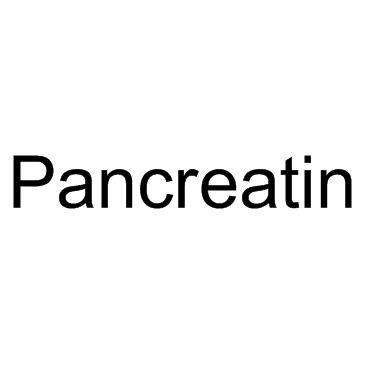Pancreatin

Pancreatin structure
|
Common Name | Pancreatin | ||
|---|---|---|---|---|
| CAS Number | 8049-47-6 | Molecular Weight | 300.435 | |
| Density | 1.0±0.1 g/cm3 | Boiling Point | 462.8±14.0 °C at 760 mmHg | |
| Molecular Formula | C20H28O2 | Melting Point | N/A | |
| MSDS | Chinese USA | Flash Point | 350.6±11.0 °C | |
| Symbol |


GHS07, GHS08 |
Signal Word | Danger | |
Use of PancreatinPancreatin is the porcine pancreas extract (PPE) which contains the main pancreatic digestive enzymes. |
| Name | Pancreatin |
|---|---|
| Synonym | More Synonyms |
| Description | Pancreatin is the porcine pancreas extract (PPE) which contains the main pancreatic digestive enzymes. |
|---|---|
| Related Catalog | |
| In Vitro | Pancreatin is the porcine pancreas extract (PPE) which contains the main pancreatic digestive enzymes. The amount of free fatty acids (FFAs) titrated at pH 6.5 does increase by 120 and 28% for II-LC and IIIA-LC, respectively, when Pancreatin is increased from 150 to 900 USP U/mL, and the total extent of lipolysis increases by 79 and 28% II-LC and IIIA-LC, respectively. By elevating Pancreatin activity from 150 to 900 USPU/mL, the total extent of digestion on average for LC-LBFs increases by 51%, whereas the amount of FFAs detected at pH 6.5 increases by 55% on average. An increase in extent of digestion is also observed with increasing Pancreatin levels[1]. |
| References |
| Density | 1.0±0.1 g/cm3 |
|---|---|
| Boiling Point | 462.8±14.0 °C at 760 mmHg |
| Molecular Formula | C20H28O2 |
| Molecular Weight | 300.435 |
| Flash Point | 350.6±11.0 °C |
| Exact Mass | 300.208923 |
| LogP | 6.83 |
| Appearance of Characters | powder | beige |
| Vapour Pressure | 0.0±2.5 mmHg at 25°C |
| Index of Refraction | 1.556 |
| Storage condition | −20°C |
| Stability | Stable. Incompatible with alcohols, strong acids. |
| Water Solubility | Soluble or partly soluble in water forming a slightly turbid solution; practically insoluble in ethanol (96%) and in ether . | Soluble in water. Insoluble in alcohol and ether. |
| Symbol |


GHS07, GHS08 |
|---|---|
| Signal Word | Danger |
| Hazard Statements | H315-H319-H334-H335 |
| Precautionary Statements | P261-P284-P304 + P340-P305 + P351 + P338-P342 + P311 |
| Hazard Codes | Xn |
| Risk Phrases | 36/37/38-42-42/43 |
| Safety Phrases | S24;S26;S36/S37;S37/S39 |
| RIDADR | NONH for all modes of transport |
| WGK Germany | 1 |
| RTECS | RT9033000 |
|
ATG16L1 phosphorylation is oppositely regulated by CSNK2/casein kinase 2 and PPP1/protein phosphatase 1 which determines the fate of cardiomyocytes during hypoxia/reoxygenation.
Autophagy 11 , 1308-25, (2015) Recent studies have shown that the phosphorylation and dephosphorylation of ULK1 and ATG13 are related to autophagy activity. Although ATG16L1 is absolutely required for autophagy induction by affecti... |
|
|
In Vitro Evaluation of Cu, Fe, and Zn Bioaccessibility in the Presence of Babassu Mesocarp.
J. Agric. Food Chem. 63 , 6331-7, (2015) In vitro gastrointestinal digestion of babassu mesocarp in the absence and presence of milk and lignin was performed to evaluate the bioaccessibility of Cu, Fe, and Zn. Extractions using NaOH solution... |
|
|
Enzymes enhance degradation of the fiber-starch-protein matrix of distillers dried grains with solubles as revealed by a porcine in vitro fermentation model and microscopy.
J. Anim. Sci. 93 , 1039-51, (2015) Effects of treating corn and wheat distillers dried grains with solubles (DDGS) with a multicarbohydrase alone or in combination with a protease on porcine in vitro fermentation characteristics and th... |
| (9cis)-Retinoic acid |
| Alitretinoin |
| (2E,4E,6Z,8E)-3,7-dimethyl-9-(2,6,6-trimethylcyclohex-1-en-1-yl)nona-2,4,6,8-tetraenoic acid |
| 9-cis-retinoic acid |
| intrazyme |
| 9Z-retinoic acid |
| ilozyme |
| pankreon |
| 9-cis-Tretinoin |
| Retinoic acid, (9cis)- |
| beefviokase |
| diastasevera |
| panteric |
| EINECS 232-468-9 |
| pancrex-v |
| pankrotanon |
| 9(Z)-Retinoic acid |

